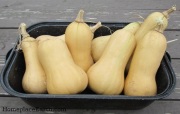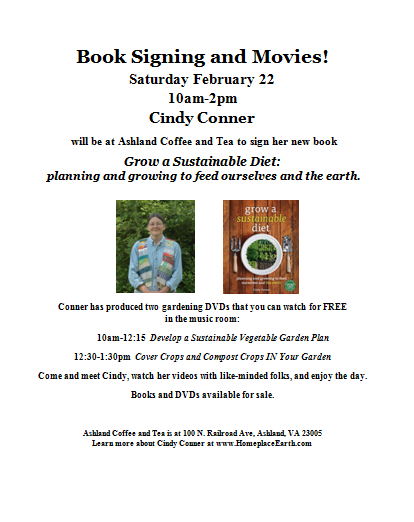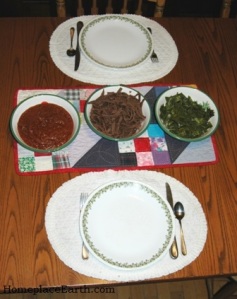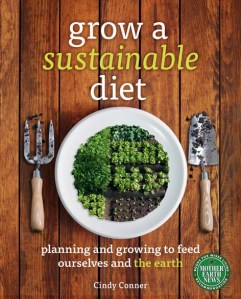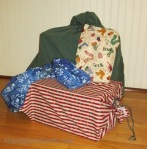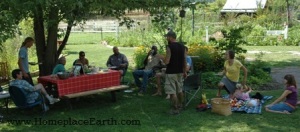 How Much to Grow is the title of Chapter 4 in Grow a Sustainable Diet. If your garden is small and whatever you get from it is a welcome addition to your table, you might not be concerned with exactly how many pounds are produced of anything. You are just happy to have homegrown food in your meals. If you want to be able to predict how much your harvest will be so you can plan to have a certain amount for your family to eat, you can put pencil to paper now and do some calculating.
How Much to Grow is the title of Chapter 4 in Grow a Sustainable Diet. If your garden is small and whatever you get from it is a welcome addition to your table, you might not be concerned with exactly how many pounds are produced of anything. You are just happy to have homegrown food in your meals. If you want to be able to predict how much your harvest will be so you can plan to have a certain amount for your family to eat, you can put pencil to paper now and do some calculating.
Chapter 4 contains a worksheet (you see part of it here) to help with those calculations. (There is a link in the book that will take you to PDFs of all the worksheets so you can print them out.) Whether you are trying to decide how much to grow for your family or for your CSA, the process is the same. Decide how much you want for each week and how many weeks you will be eating it, or in the case of a CSA, how many weeks you need to put it in the CSA boxes. If you have no idea how many pounds of something you need, go to the grocery store and pick out a reasonable quantity for a meal in the produce department. Weigh it on the scale that is right there. Multiply that weight by how many meals per week that item will supply and you have the pounds needed per week. The number of weeks you want to eat something could be only the weeks it is fresh from the garden, or every week of the year if you are preserving for eating out of season. Rather than the weight, you may need to know the count; how many of something you will have, such as butternut squash. Sometimes you can find that information in the seed catalogs, and sometimes not. From my experience, I know that I can expect about 4 squash per plant. If the catalog doesn’t have that information for the variety you choose, read the description of all the varieties, as well as the specifics for each crop to get an estimate.
Finding out how much is needed is the easy part. You need to know how much you can grow in your area and pounds/100 ft² is a good universal measure to use. How to Grow More Vegetables by John Jeavons has Master Charts that can help you with that. The Master Charts have columns for Biointensive yields and for the US Average for each crop. Use those figures as guidelines. Your yield will depend on many factors, including your soil, climate, and management style. You might already know how much you can harvest in the area planted. If not, this exercise should encourage you to record your harvests this year, at least for the crops you are most interested in.
Remember the charts are only guidelines. For the Biointensive yield, the Master Charts give three numbers; the beginning yield that you could expect getting at some time, the intermediate yield that could be reached after good soil building, and a high yield that few might reach. The Biointensive yield of winter squash is shown as 50/100/350. There is no US Average shown in the Master Charts, but my research determines that number to be 49.5 pounds/100 ft². The target yield I use for butternut squash is 150 pounds/100 ft². I have reached that yield and sometimes higher in my garden. For cowpeas, the Biointensive yield is 2.4/4/5.9. The US Yield of cowpeas isn’t shown, but through my research I’ve determined it to be 2.6 pounds. I live in a great climate for cowpeas and have found I can use 5 pounds/100 ft² as my target yield. On the other hand, I would love to plan on getting 100 pounds/100 ft² regularly with my potatoes, but the voles keep the yield below that. The Biointensive yield for potatoes is 100/200/780 and the US Average is 84.2. Depending on the variety, I don’t always reach the low Biointensive yield of 100 pounds for tomatoes. The US Average for tomatoes is 67 pounds for fresh and 153.4 pounds for processing tomatoes per 100 ft².
From your garden map you will know how much space you have available. My post Making a Garden Map can help you with that. It becomes a balancing act, deciding how much space to allot for each crop. Having a target yield makes planning easier. Your target yield may need to be adjusted from year to year, but at least you have someplace to start from. Between cover crops and food crops, plan to have your beds full all year. Immediately after your early spring crops are harvested, plant the next crop. Leaving the beds empty is an invitation for Mother Nature to plant her favorites, which we tend to think of as weeds.
The rest of the page of the How Much to Grow worksheet that you don’t see is a space for comments and three columns for the amount of calories, protein, and calcium per pound of food. It is always good to leave space for comments—something about that crop you want to remember. Since I keep records for my certification as a GROW BIOINTENSIVE Sustainable Minifarming teacher, I am interested in the amount of calories, protein, and calcium in each crop. There might be other things that you want to record in those additional columns.
Use this information to enhance what you are doing, but don’t let it overwhelm you. Keep track of what you can. As you find you have more questions, add the appropriate recordkeeping to your system. Most importantly—have fun in your garden this year!
